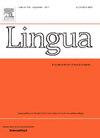Sequential patterns of lexical categories in Chinese–English interpreting: Insights into linguistic and cognitive constraints
IF 1.3
3区 文学
0 LANGUAGE & LINGUISTICS
引用次数: 0
Abstract
Previous research has investigated lexical category distribution across different modes of interpreting, but the structural relationships within lexical categories that underpin grammatical and semantic information remain unexplored. To address this gap, this study employed part-of-speech (POS) distance, a metric quantifying the linear distance between a POS unit and its next repetition, to analyze the structural patterns within lexical categories across a corpus of consecutive interpreting (CI) and simultaneous interpreting (SI). The analyses included descriptive statistics and inferential functional modeling of POS distances using the Zipf–Alekseev (ZA) model. The results revealed significant, mode-specific discrepancies and irregularities in the sequential organization of lexical categories, alongside overarching regularities shared by CI and SI. Notably, CI is characterized by a sparser distribution of short-distance POS repetitions and a lower value of parameter b in the ZA model. These patterns persisted when potential confounders were accounted for. The results were interpreted in light of the linguistic and processing constraints involved in these interpreting modes. The findings exemplify how language production operates dynamically through the interplay among linguistic, cognitive, and contextual constraints. This study also offers methodological insights relevant to various aspects of linguistic studies.
汉英口译中词汇范畴的顺序模式:对语言和认知约束的洞察
以往的研究已经研究了不同口译模式下词汇类别的分布,但词汇类别之间的结构关系是语法和语义信息的基础,这一点尚未得到探索。为了解决这一差距,本研究采用词性距离(POS)来分析交替传译(CI)和同声传译(SI)语料库中词汇类别的结构模式。词性距离是一种量化词性单位与其下一次重复之间线性距离的度量标准。采用Zipf-Alekseev (ZA)模型对POS距离进行描述性统计和推理功能建模。结果显示显著的,模式特定的差异和不规则的顺序组织的词汇类别,以及总体规律共享的CI和SI。值得注意的是,CI的特点是短距离POS重复分布更稀疏,ZA模型中的参数b值更低。当考虑到潜在的混杂因素时,这些模式仍然存在。根据这些口译模式所涉及的语言和加工限制,对结果进行了解释。这些发现说明了语言生产是如何通过语言、认知和语境约束的相互作用动态运作的。本研究还提供了与语言学研究的各个方面相关的方法论见解。
本文章由计算机程序翻译,如有差异,请以英文原文为准。
求助全文
约1分钟内获得全文
求助全文
来源期刊

Lingua
Multiple-
CiteScore
2.50
自引率
9.10%
发文量
93
审稿时长
24 weeks
期刊介绍:
Lingua publishes papers of any length, if justified, as well as review articles surveying developments in the various fields of linguistics, and occasional discussions. A considerable number of pages in each issue are devoted to critical book reviews. Lingua also publishes Lingua Franca articles consisting of provocative exchanges expressing strong opinions on central topics in linguistics; The Decade In articles which are educational articles offering the nonspecialist linguist an overview of a given area of study; and Taking up the Gauntlet special issues composed of a set number of papers examining one set of data and exploring whose theory offers the most insight with a minimal set of assumptions and a maximum of arguments.
 求助内容:
求助内容: 应助结果提醒方式:
应助结果提醒方式:


